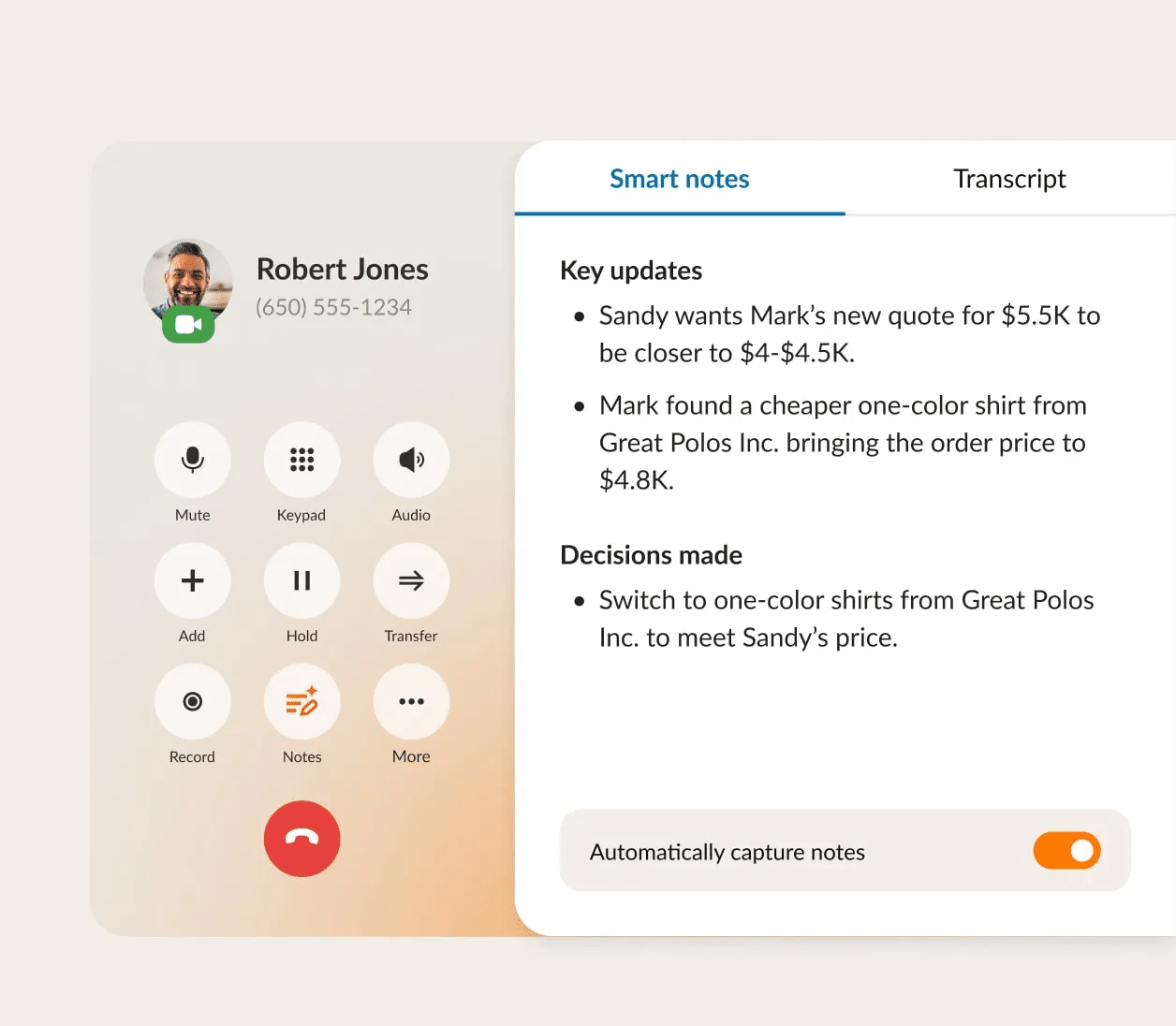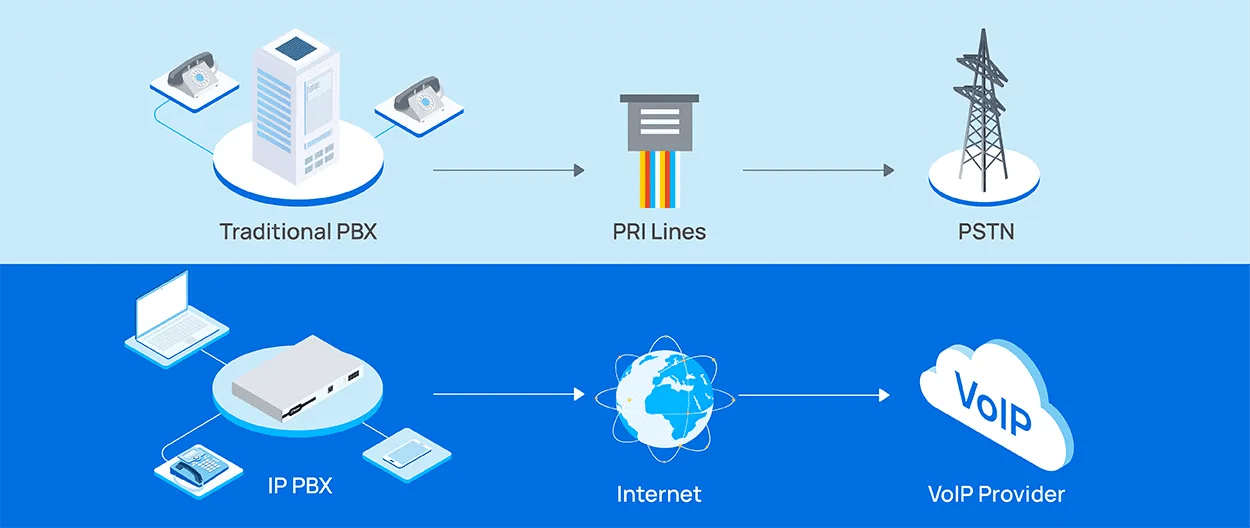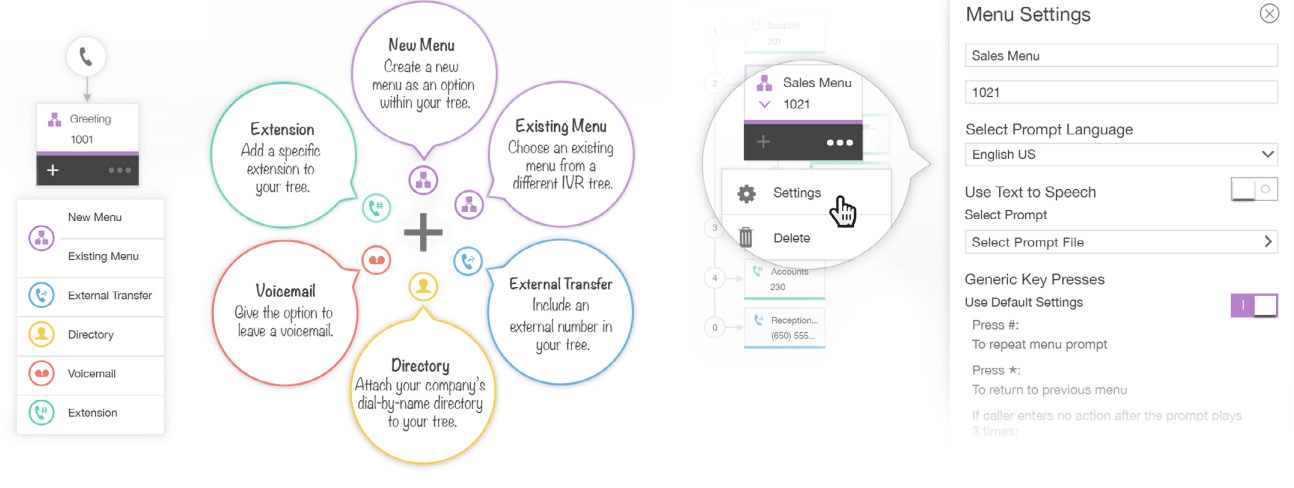Businesses like yours are continually replacing aging technology with new and improved solutions. For communication, this means making the right choice in the VoIP vs. landline debate.
The VoIP services market was valued at over $115 million in 2022 and is projected to eclipse $472 million by 2033.
Voice over Internet Protocol (VoIP) has emerged as the best option for flexible business communications. Sure, those landline phones you have kicking around the office still get the job done, but could your phone system do more?
In this guide, we’ll explain the differences, pros, and cons of VoIP vs. landline phones.
What is VoIP?
VoIP is technology that can connect callers and transmit voice signals over the web, rather than using a traditional public switched telephone network (PTSN)–also sometimes known as the plain old telephone service (POTS)–to make a call.
When making a call using VoIP telephony, you dial a number with a virtual phone or VoIP service that connects to another VoIP or landline network.
VoIP phone services enable businesses to stop relying on hard-wired phone lines. Instead, they only need a mobile phone, computer, or VoIP-enabled desk phone with a VoIP app and internet access (be that via broadband, WI-FI, Ethernet, whichever).
VoIP phone systems offer many more advanced features than a traditional private branch exchange (PBX).
How does VoIP work?
Externally, a cloud PBX and other VoIP services work much like any other type of phone. It’s what’s happening behind the scenes that’s different.
First, you need your virtual phone to connect to your intended destination. Session initiation protocol (SIP) is the universal tool. It’s responsible for starting, establishing, and terminating real-time conversations.
When you speak on the phone, your voice is converted into digital packets that travel over the internet. Real-time transport protocol (RTP) carries these media streams back and forth between callers.
Once they reach the recipient, the data packets are transformed back into your audible voice on the other end. It’s a binary alchemy that happens thanks to codecs, such as G.728 and Opus, that convert and un-convert human speech. This happens continuously as each caller takes their turn to speak.
For both callers, the entire experience is instantaneous. You speak, and the person on the other line hears your voice like any other phone call.
What is a landline?
At the simplest level, a landline is a copper wire connected to a physical location, such as an office, that carries analog phone signals.
It’s the same hard-wired technology that you’ve likely used for personal phone calls in your home, simply referred to as the plain old telephone service (POTS).
Landline telephone systems have experienced some evolution, but are essentially based on century-old technology. Today, businesses use a PBX phone system for both internal and external calls. Using a PBX enables multiple team members to use different phones with the same number.
You’re probably already familiar with the mechanics of placing a phone call through a PBX. You pick up the phone and listen for a dial tone. After dialing a number, you connect to a phone provider on the PSTN which routes your call to the recipient. When you speak into the phone, an electric signal carries your voice across physical phone lines. The electric signal reaches the phone of the person on the opposite end of the line.
A landline PBX is great for businesses that only need to make calls in the local area and have no plans to expand or move.
Those who need more features like call analytics, unified communications, AI-powered insights, and more, can look for virtual and cloud-based PBX solutions that use VoIP for phone and video calls.
VoIP vs. landline for business: Key differences
Today, both VoIP and landline phones are used by businesses all over the world. Some prefer the trusty POTS and its 100-year-plus track record. Others desire their phone systems to offer more freedom and greater capabilities. Each organization has its reasons for sticking with the phone systems of their choice.
The question is, where do you fall in the VoIP phone vs. landline phone debate?
Answering that question starts by understanding the differences between VoIP and landline phones:
Equipment & setup
Chances are, you’re already using a landline for your business. The equipment is already on-site, such as copper wires, phone jacks, and desk phones.
Of course, someone spent a considerable amount of money to create that infrastructure. Those costs are likely baked into the costs of your location overhead.
But what if you hire more employees and need new user extensions? You’ll need to purchase and install new equipment, including phone lines. Line installation can take days to weeks, and cause disruption to operations. A phone number may also need to be set up with your local phone company.
Installing and setting up a new landline phone system requires an even greater upfront investment of time and money.
Conversely, VoIP phone systems are hosted by vendors, and you access them online. You’ll need minimal equipment as long as your business already has an internet service provider—you can simply use existing laptops, PCs, and mobile devices. Once you sign up with a virtual phone system, download and install the desktop or mobile app.
You can usually set up a number and account in minutes. Setting up a system for your entire business may take up to a day.
Features
A solution like a landline-based PBX can often do more than just make and receive calls. Features include auto-attendants that greet and route callers with pre-recorded messages and menus that enable callers to dial extensions that ring the right department or individual.
Other landline features include voicemail, call transfer, three-way calling, and call forwarding.
VoIP services offer all of the same features as landline telephones and much more. Instead of a basic auto-attendant, you may get Interactive Voice Response (IVR) menus. IVR menus enable callers to use voice commands to navigate to the correct phone line.
Advanced call routing lets you create ring rules and other ways to make sure customer calls are never missed. Some business phone platforms, too, come with AI-powered capabilities.

For example, RingCentral RingEX comes with a built-in AI personal assistant. RingSense AI automatically transcribes conversations and creates smart notes for every call.
VoIP technology is evolving. Incorporating AI technology means you can only expect progressively more advanced call features.
Costs
Installing new landlines requires a heavy investment. You’ll also pay a monthly or annual fee to the local phone company. In addition, you’ll need to buy a desk phone for every number, extension, or employee. If anything on-site breaks, you’ll also need to pay to replace it. As systems age, they become more challenging to maintain as parts become harder to source and limited supply makes them even more expensive.
With VoIP, you don’t need any equipment besides an internet-connected device. Some services even let you make calls from a browser-based app. Simply sign up with a provider and then create your account and set up your phone number.
You’ll pay a monthly or annual fee per user of your VoIP system. There are no extra costs unless you add more features or users.
Scalability
Both VoIP and landlines are scalable. However, they arrive at your destination from different pathways. With landlines, you’ll need to connect new phones to the CPU and operating console. Once you run out of phone lines, you’ll need to install new lines and equipment.
VoIP services offer nearly unlimited scalability. With most providers, you can add new users or phone numbers in minutes. Did you hire a bunch of new team members? VoIP makes instant productivity a breeze. A bring your own device (BYOD) policy lets them use a device they already own and are comfortable with. Create an account and have them install the VoIP app on their desktop or smartphone.
Thinking about handling customer support instead of outsourcing? AI-powered platforms like RingCentral offer fully integrated cloud contact centers for rapid deployment.
Security
A landline-based PBX gives you full control over communication security. Only those with physical access can gain entry to the system. Having measures in place such as on-site security teams ensure only authorized personnel use your phone lines.
Any time data is transmitted over the internet, there are associated risks. VoIP is just as vulnerable as any other hosted service for business. With VoIP-based PBX systems, you may worry about sensitive customer data stored in call recordings and other formats.
That’s why it’s critical to choose a provider with end-to-end encryption, single sign-on, and other security features.
Reliability
Traditional landline phones are extremely reliable—that’s why they haven’t changed much in over 100 years! If the power cuts out, analog phones and lines will still be working. Telephone line infrastructure is so widespread in places like the US, that it’s unlikely you’ll experience service downtime. But landline systems that aren’t properly maintained may experience downtime, and you’ll be solely responsible for restoring service. And if you need to source parts or experience downtime during the evening or on a weekend, you may be facing an extended outage.
VoIP phones are also extremely reliable. Sure, you may be more susceptible to power outages, but it’s likely your laptop and mobile phone will still have plenty of juice for conducting business communications.

Virtual PBX providers also use redundant data centers spread around the US and the world. If one site goes down, your service will automatically connect to the next closest location. Industry leaders RingCentral provide a service level agreement (SLA) of 99.999% uptime in 46 countries.
Mobility & flexibility
Landlines were never designed to be mobile. You go to your desk to make or receive a call. There are wireless handsets that offer users the ability to wander a few hundred or even a few thousand feet from the base. Your mileage may vary as the signal strength is affected by the thickness of the walls at the business location.
What about landline flexibility? Well, this isn’t its strength either. An analog PBX system’s stability and reliability is founded on its lack of flexibility. The lines are always in the same place. The phones are always in the same place.
As a result, a landline PBX isn’t particularly suitable for remote and hybrid teams.
VoIP business phones offer maximum mobility and flexibility to users. First, you can access the service from anywhere with a network connection. Your team can handle calls while stepping away from their desk or when off-site.
Virtual business phones empower a BYOD policy. Your employees can work from their preferred devices, whether it be a laptop, cell phone, or VoIP desk phone. Features like Call Flip with RingCentral give added flexibility, enabling you to seamlessly switch between devices without interrupting the conversation.
A VoIP platform also includes and supports your remote teams. Everyone in the company can access the system from anywhere in the world.
Why switch to VoIP? Pros and cons for businesses
The differences between landline phones vs. VoIP phones may not produce a clear-cut winner. It depends on how your business operates today and its plans for the future.
There’s nothing that helps clarify the best choice of whether you should switch from landline to VoIP like evaluating the pros and cons of each communication solution:
Pros
Let’s first examine the pros of switching to VoIP:
- Save money: VoIP pricing plans are straightforward and cost-effective. You only pay for what you need. You’ll save even more by signing up for an annual plan. You avoid the upfront maintenance for maintaining copper lines and other communications infrastructure. Capital expenditures in hardware like PBX servers and desk phones aren’t needed. Plus, international and long-distance calls often have lower rates, too.
- Gain new capabilities: Access intelligent call routing, call analytics, and AI-powered features.
- Adapt the system easily to your needs: Add new users, numbers, and features as and when you need for greater business adaptability.
- Support flexible working: Empower teams to work from anywhere and on their preferred devices.
- Streamline workflows: A virtual PBX comes with native integrations to connect to your existing business tools. Connect apps like your CRM and automate manual tasks to increase productivity.
- Benefit from unified communications: Handle all of your business communications from one platform. Text, call, and chat with just a few clicks. Plus, handle video conferencing, online fax, and more, via your business VoIP solution.
- Redundancy: No worrying about hardware failure. All your data is backed up at multiple vendor sites.
- Deploy the system rapidly: A VoIP business phone system can be deployed in minutes to hours. Your team will be dialing on their desktops and mobile phones right away.
- Have a system that’s ready for the future: In the USA, the FCC has already started to remove carriers’ responsibilities to maintain the PSTN. The VoIP vs. landline UK debate will end in 2025 when the government switches off its PSTN services entirely. Australia already began disconnecting copper lines in 2023.

Cons
The following are the cons of switching to VoIP:
- Unfamiliar: You may already be comfortable with using a traditional business PBX. Your team must be willing to adapt to new technologies, even if they’re easy to use. Some onboarding and training may be required for each employee to get the most out of the new system.
- Call quality: The quality of calls placed through VoIP can vary based on the strength of your connection. Latency, jitter, and packet loss can all affect the quality of the call. Traditional landlines are less susceptible to diminished call quality.
- Dependency on Internet Service Providers (ISPs): Many VoIP calls will be placed through your internet connection. If your ISP frequently experiences outages or delivers slow speeds, the quality of calls may suffer.
- Compatibility: Some VoIP services may not be compatible with desk phones or alarm systems you already own.
Popular VoIP features to consider
Most businesses find that making the switch to VoIP is the best option. Now, the real work begins. There are so many virtual phone systems available, how do you narrow down the search?
Start by looking for platforms that offer must-have VoIP features:
Auto-attendant
An auto-attendant is familiar to traditional PBX users. Landline systems often come with a basic answering system that greets callers with pre-recorded messages. Callers navigate the menu by pressing a number on their phone.
A VoIP auto-attendant comes with more capabilities and plenty of customization options. Platforms like RingCentral allow users to use voice commands as well as use the keypad to get to the person they’d like to speak to.
It also allows you to build much more sophisticated menu trees to handle and deflect incoming calls. Intelligent auto-attendant services can empower your customers with self-service, letting your reps focus on more complex issues.
Virtual voicemail
VoIP business phone solutions should come with some form of virtual voicemail. It’s a feature that lets you access and manage your voicemails from your cell phone or desktop app. You can forward voicemails to other members of your team with a few taps.
AI-powered unified communications platforms like RingCentral RingEX go one step further with visual voicemail. Our AI assistant automatically transcribes every voicemail. Read your voicemails in the app when in noisy environments. Forward voicemail transcriptions to your colleagues as and when needed.
Sure, a landline phone system comes with voicemail. You can listen to and delete messages. Voicemail forwarding is more difficult if it’s even offered, and don’t even think of accessing your messages from your cell phone.
IVR
Interactive voice response is one of the many VoIP features that you’ll rarely find with a traditional PBX.
IVR offers more submenus with advanced call flow customization. You aren’t restricted to specific extensions and voicemail boxes. Callers can access a dial-by-name directory or other call-center automation.

Contact centers are where IVR really shines. Multi-level IVR relieves your support agents during peak call volumes by routing callers and managing call queues. You can configure routing options based on business hours.
If a customer calls when you’re closed, the IVR fast-tracks them to voicemail or other alternatives. Intelligent IVR with RingCentral enables even the smallest of businesses to offer a form of 24/7 customer support.
Call forwarding
VoIP phone systems come with call forwarding and other routing capabilities. Set up custom rules for incoming calls to facilitate sequential or simultaneous calls. You can also prioritize calls on set criteria, such as account history or forward customer calls straight to voicemail.
You’ll never miss an important call again. When out of the office, after a predetermined amount of rings, your work phone number can forward calls to your personal number. You can set this for VIPs or for those times when you’re on a call.
Alternatively, set up forwarding to ring an available team member if you’re busy or away from your device.
An on-premises PBX can also do call forwarding. Your options will be quite limited, and changing settings also isn’t as intuitive. Forwarding calls based on operating hours or stepping away from your desk often just isn’t practical with analog systems.
Cost of VoIP vs. landline
Most business decisions come down to your budget. Even if you have unlimited resources, you still want to get value for money. So, it’s vital to consider VoIP vs. landline costs when it comes to business phone systems:
VoIP cost considerations
- Hardware: This is your on-premises network, including ethernet ports and wireless routers. Your site likely already has this equipment. People doing remote work will use their own equipment.
- Internet: Your monthly payment to your provider. (Again, you’re already paying for this for normal business operations).
- Phones: You can purchase VoIP desk phones if you want, but they’re not necessary. Team members can use either company-owned or personal desktops and smart devices.
- Maintenance and upkeep: VoIP has minimal maintenance costs. You’ll periodically replace equipment like computers to keep up with daily operations. Your provider maintains VoIP infrastructure.
- VoIP package: Recurring monthly or annual fee based on the number of users or extensions you need. Most packages start as low as $20 per user, per month.
- International calling: Virtual business phone services offer low long-distance rates. They also enable you to buy local phone numbers.
Landline cost considerations
- Hardware: Use your existing equipment for PSTN phone calls. You’ll need to pay fees running from hundreds to thousands of dollars to replace or add new copper phone lines. If you don’t have an on-premises PBX, you’ll also have to buy a PBX operating console and other equipment.
- Phone company: Pay a monthly fee to your carrier for access to the local phone number. You’ll have to pay additional fees for each phone line.
- Phones: PBX desk and conference phones for employees and meeting rooms. Prices can vary widely depending on what you need. Every new team member will need their own phone.
- Maintenance and upkeep: All equipment will need to be replaced regularly. If a line is faulty, you’ll need to pay to get the experts in to solve the problem. You’ll also need IT communications experts in-house for regular maintenance.
- International calling: You’ll be at the mercy of the phone company’s long-distance rates. Without the option to port local numbers, you’ll spend more on external calls outside of your local area.
VoIP vs. landline: Which is right for your business?
We’ve greatly explored the landline phone vs. VoIP debate. After the dust settles, which one is the right choice for your business?
Well, VoIP is the best option if your business:
- Plans on experiencing short-term and long-term growth, hiring new people regularly.
- Expects to expand to new offices in different geographic regions.
- Wants to be inclusive and empower remote and hybrid teams.
- Aims to reduce expenditures and have consistent, transparent pricing for business communications.
- Can benefit from unified communications and streamlined workflows.
- Needs advanced call routing and greater customization of your communications.
- Wants to work smarter with the aid of an AI-powered personal assistant.
If none of those reasons apply to your future plans, you’re probably okay sticking with your faithful landline phones.
RingCentral is the AI-powered unified communications platform for businesses looking for flexibility, value, and increased efficiency. Sign up for a free trial today and find out how our platform elevates collaboration.
VoIP vs. landline FAQs
Can VoIP replace a landline phone?
Yes. VoIP allows you to call any other virtual or landline-based phone number just like a traditional analog system. VoIP allows you to make calls through the internet, and the best VoIP solutions aren’t just about voice calls, either. They also come with greater functionality, to help you with video calling, SMS business texting, advanced call routing, eFax, and other features.
Is VoIP reliable?
VoIP is very reliable. As long as you have a stable network connection, you can experience HD video and audio during calls (ensuring top visual and sound quality), with the right provider.
You can trust VoIP more than landline systems for data reliability. VoIP providers use multiple redundant data centers. If one goes down, your data and service are safely stored at another location.
AI-powered unified communications platforms like RingCentral RingEX provide 99.999% uptime in 46 countries. You’ll always have service when you need it.
Who should use VoIP services?
VoIP service providers cater for freelancers, small businesses, large enterprises, and anything in between. A virtual PBX system that uses VoIP is a must-have for companies that work with remote and hybrid teams.
VoIP helps SMBs professionally handle higher call volumes without breaking the bank. Features like local number portability, auto-attendants, and integrated call centers help level the playing field despite having fewer resources.
What are the disadvantages of using VoIP?
There aren’t many disadvantages to using VoIP for your business. The main disadvantages are security and internet connectivity. The former relates to the fact that anything online is accessible to malicious hackers and eavesdropping.
However, platforms like RingCentral protect your data with end-to-end encryption and single sign-on.
VoIP call quality and performance are also dependent on your internet connection. If your signal is weak or your bandwidth is low, you may experience stutter, packet loss, and disconnections during a call.
How much does VoIP cost?
VoIP costs depend on what features you need and the size of your business. In general, you can expect to pay $20 to $30 per user, per month for reasonably comprehensive setups. You’ll often enjoy lower costs if you sign up for an annual pricing plan instead of a monthly one.
How do I switch to VoIP?
Switching to a VoIP provider is easy. Choose a service that fits your needs and budget. Contact the virtual business phone provider and sign up for a suitable package. After that, you only need a desktop, mobile, or browser-based application.
Log in to your account, configure some settings, and test out VoIP calling. The whole process can be done in minutes to hours.
Originally published Sep 08, 2024, updated Nov 25, 2024





